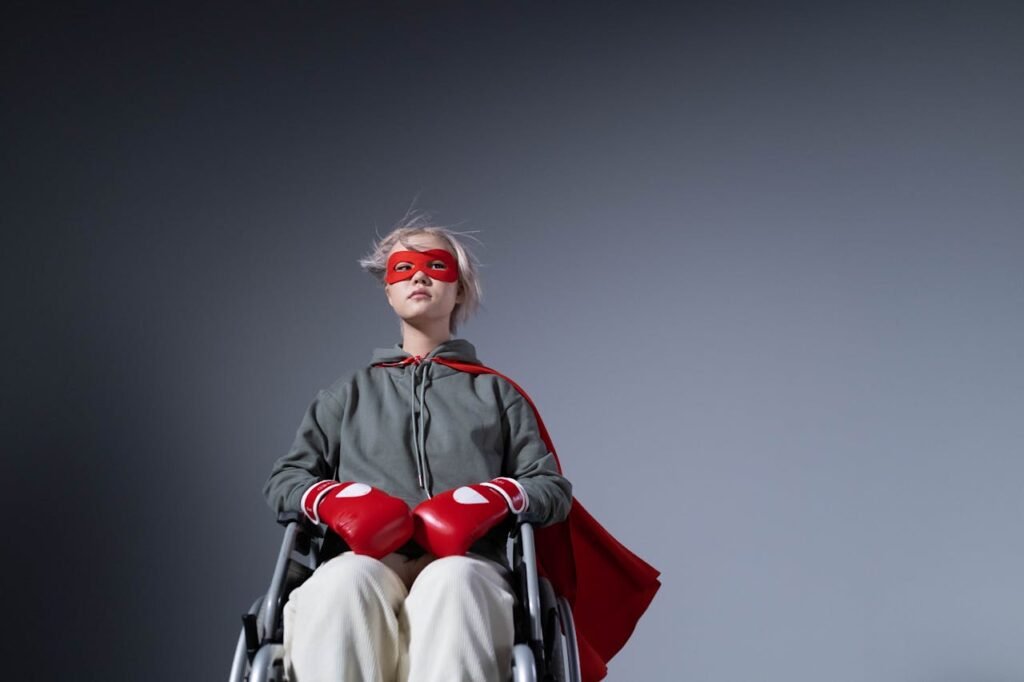Superheroes have always represented strength, resilience, and determination, but in recent years, pop culture has begun embracing a new kind of hero—one with disabilities and prosthetics. From comic books to blockbuster films, disabled superheroes are breaking barriers, proving that limb loss or mobility challenges do not define a person’s abilities.
As prosthetic technology evolves, media is changing how society perceives prosthetic users. Instead of being portrayed as helpless or broken, disabled superheroes are now leaders, warriors, and role models, showing audiences that a prosthetic limb can be a symbol of power rather than a limitation.
This article explores how pop culture is redefining prosthetics through superheroes, why these portrayals matter, and what they mean for real-life prosthetic users.
Superheroes with Disabilities: Changing the Narrative
Superheroes with disabilities are shifting how the world sees prosthetic users, transforming them from symbols of tragedy to icons of power and resilience.
From Tragic to Triumphant: A Shift in Disability Representation
For a long time, characters with disabilities in pop culture were often portrayed as tragic figures—individuals who were defined by their loss rather than their strength. They were usually written as side characters, victims, or obstacles for the main hero to overcome.
However, modern storytelling is changing this narrative. Superheroes with prosthetic limbs or disabilities are no longer objects of pity—they are leaders, warriors, and innovators. They show that disability is not a weakness, but rather a different way of experiencing the world.
By seeing superheroes who use prosthetics fight villains, save lives, and lead teams, audiences develop a more positive and inclusive perspective on limb loss and disability. These portrayals help normalize prosthetics, showing them as functional, empowering, and even futuristic tools.
The Influence of Pop Culture on Real-Life Perception

When movies, TV shows, and comics showcase strong, capable prosthetic users, it changes how society views real-life amputees. Instead of assuming that people with limb loss are limited or dependent, audiences begin to associate prosthetics with independence, strength, and adaptability.
This shift in perception can have real-world benefits. It can lead to:
- More inclusivity in workplaces and schools, as people recognize that prosthetic users can perform just as well as anyone else.
- Better accessibility in public spaces, as society begins to prioritize disability-friendly environments.
- Increased interest in prosthetic innovation, as designers and engineers look to pop culture for inspiration.
The more media presents prosthetic users as capable and powerful, the more real-life barriers are broken down.
Encouraging Prosthetic Users to See Themselves as Heroes
For children and adults with limb loss, seeing a superhero who looks like them can be life-changing. It provides representation, inspiration, and confidence, showing them that they can achieve great things, regardless of physical differences.
When a child with a prosthetic limb sees a superhero fighting battles, saving the world, and standing strong, they begin to believe that they, too, are capable of greatness. This is why accurate, empowering portrayals in pop culture are so important—they shape self-esteem, ambition, and societal attitudes.
Famous Superheroes with Prosthetics and Disabilities
Superheroes with prosthetic limbs are not just characters; they are symbols of resilience, showing how technology and human willpower can work together.
Winter Soldier: A Symbol of Strength and Adaptation
One of the most well-known superheroes with a prosthetic limb is Bucky Barnes, aka the Winter Soldier, from the Marvel Cinematic Universe (MCU). After losing his arm, he is given a high-tech prosthetic arm that allows him to fight, adapt, and become one of the most formidable warriors in the MCU.
Bucky’s story is not about loss—it’s about resilience. Despite his past struggles, he proves that a prosthetic does not limit his abilities. His arm is not just a replacement—it’s a powerful tool that makes him stronger and more capable.
His portrayal has inspired many prosthetic users, showing that limb loss does not take away a person’s strength, identity, or ability to fight for what is right.
Cyborg: Merging Humanity with Technology
Cyborg, a major character in DC Comics and the Justice League, represents the future of prosthetic integration. After a tragic accident, he is rebuilt with advanced cybernetic enhancements, making him stronger and smarter than ever before.
His story reflects the real-world advancements in bionic prosthetics, where technology is helping amputees regain function and even exceed natural human abilities. Cyborg proves that prosthetic limbs are not just about replacing what was lost—they are about enhancing what is possible.
By showing a superhero who embraces his prosthetics as part of his identity, Cyborg helps audiences see limb loss in a new light—not as a disability, but as an evolution.
Iron Man: A Hero with an Invisible Disability
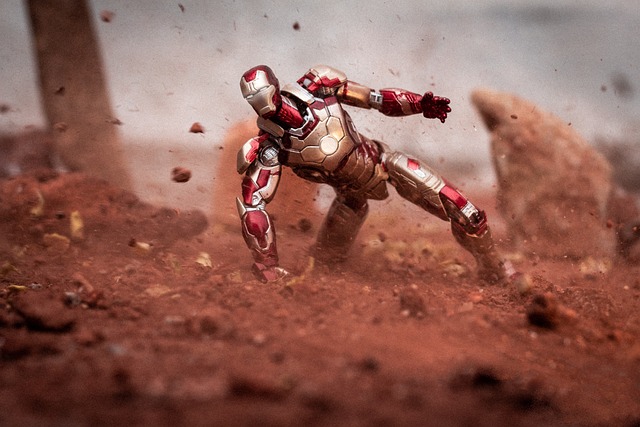
While Tony Stark (Iron Man) does not have a visible limb difference, he relies on technology to function after suffering severe chest injuries. His story resonates with many disabled individuals because it highlights the importance of assistive technology in achieving independence.
His arc shows that having a disability or using prosthetics does not diminish intelligence, capability, or leadership. Instead, it reinforces the idea that assistive technology can be a powerful equalizer, allowing people to reach their full potential despite physical challenges.
Shuri’s Prosthetic Advancements in Black Panther – Merging Innovation with Culture
One of the most underappreciated aspects of the Black Panther franchise is Shuri’s role as an innovator in prosthetic technology. In Black Panther: Wakanda Forever, we see her engineering advanced, culturally inspired prosthetics, bridging the gap between functionality, identity, and empowerment.
Strategic Business Takeaways
Cultural Relevance Matters – Prosthetic manufacturers should look beyond just functionality and aesthetics. Culturally inspired prosthetics, much like Shuri’s designs, help users feel connected to their heritage and identity. Businesses can work with local designers and cultural experts to craft prosthetics that reflect regional styles, patterns, and symbolism, rather than generic designs.
Customization as a Core Offering – In Wakanda, prosthetic users receive personalized, high-tech solutions tailored to their needs, style, and performance goals. Companies should invest in 3D printing and modular designs that allow customers to customize their prosthetics—whether through color choices, engraved patterns, or interchangeable components.
Future-Proofing Technology – Black Panther showcases next-gen assistive tech, like vibranium-enhanced prosthetics that improve agility and strength. While vibranium may be fictional, businesses should focus on integrating AI, bionics, and machine learning into real-world prosthetics to enhance usability and responsiveness.
Luke Skywalker: From War Veteran to Advocate for Bionic Innovation

Luke Skywalker’s transition from losing his hand in battle to wielding one of the most advanced cybernetic prosthetics in fiction mirrors the real-life journey of many amputees—especially war veterans and trauma survivors. His story offers businesses a guide to addressing the mental, emotional, and physical aspects of prosthetic adoption.
Strategic Business Takeaways
Address the Psychological Transition – For many amputees, the biggest challenge is not just physical recovery, but the emotional journey of adjusting to a prosthetic limb. Businesses should provide psychological support services, such as:
- Virtual reality (VR) training simulations that help new users adapt.
- Community-driven mentorship programs where experienced users guide new amputees through the transition.
- Marketing campaigns featuring real prosthetic users, showing that adjusting to a new limb is a journey, not an overnight process.
High-Performance Prosthetics for Active Users – Skywalker’s bionic hand functions like a natural limb, capable of extreme dexterity, strength, and precision. While real-world technology is still catching up, companies should focus on developing high-performance prosthetics for active users, including athletes, military veterans, and outdoor enthusiasts.
Gamification in Prosthetic Training – Luke’s rapid adjustment to his prosthetic could inspire businesses to integrate gamification and adaptive training programs into prosthetic use. For example:
- Prosthetic integration games that track grip strength, fine motor skills, and agility improvements.
- AI-driven feedback systems that provide coaching on movement patterns, reducing strain and improving efficiency.
Doctor Octopus: Rethinking Multi-Limb Assistive Devices
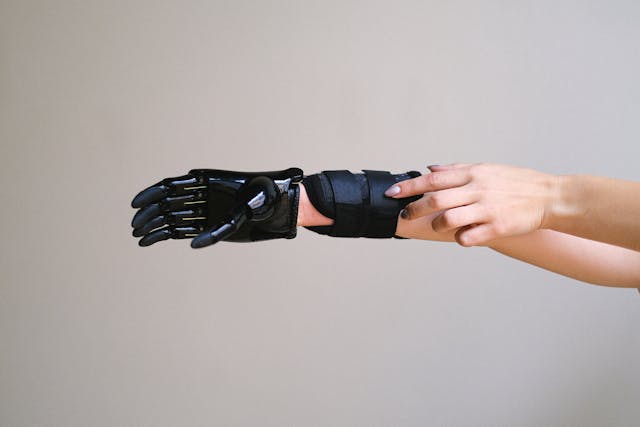
Doctor Octopus (Spider-Man) is often viewed as a villain, but his AI-powered, highly responsive robotic limbs are an incredible example of what assistive technology can achieve. His character sparks important business discussions around multi-limb assistive robotics, AI-driven prosthetics, and industrial applications for amputees and differently-abled individuals.
Strategic Business Takeaways
Exploring AI-Powered Multi-Limb Prosthetics – While traditional prosthetics replace missing limbs, businesses could develop multi-limb solutions that provide additional capabilities. This could be useful for:
- Factory workers with mobility impairments who need extra robotic support for handling heavy objects.
- Athletes who require adaptive movement technology for enhanced balance and coordination.
- Scientists, engineers, and surgeons, where extra limbs could assist in precision-based tasks.
Wearable Exoskeletons for Strength & Mobility – Doctor Octopus’s limbs act as an extension of his body, controlled by neural interfaces. Businesses can take inspiration from this by developing:
- Exoskeleton technology for stroke patients, spinal injury survivors, and elderly users, giving them greater mobility and strength.
- Mind-controlled assistive devices that react to electrical impulses from muscles or neural implants.
Balancing AI with User Safety – One of Doctor Octopus’s biggest flaws is his overreliance on AI, which eventually overrides his human control. This raises an important concern for real-world assistive tech: how much control should AI have in prosthetics? Businesses must focus on:
- User-controlled overrides to ensure prosthetic users always have final control over their device’s actions.
- Fail-safe mechanisms that prevent malfunctions and unintended movements in AI-powered prosthetics.
Building trust between humans and AI-powered prosthetics through real-time safety features and continuous learning systems.
How Pop Culture is Driving Prosthetic Innovation
Superheroes are not just inspiring stories; they are pushing real-world science to create better prosthetic technology.
Turning Fictional Prosthetics into Real Technology
Many of the prosthetic limbs seen in superhero movies inspire real-world engineers and scientists to push the boundaries of prosthetic development. High-tech arms like the Winter Soldier’s metal limb or Cyborg’s cybernetic enhancements motivate researchers to create more functional, responsive, and intuitive prosthetics.
In recent years, we’ve seen bionic limbs with advanced sensors, AI-driven movement, and even mind-controlled functionality. These innovations are bringing prosthetics closer to science fiction, improving both mobility and quality of life for amputees.
Making Prosthetics More Accessible and Stylish
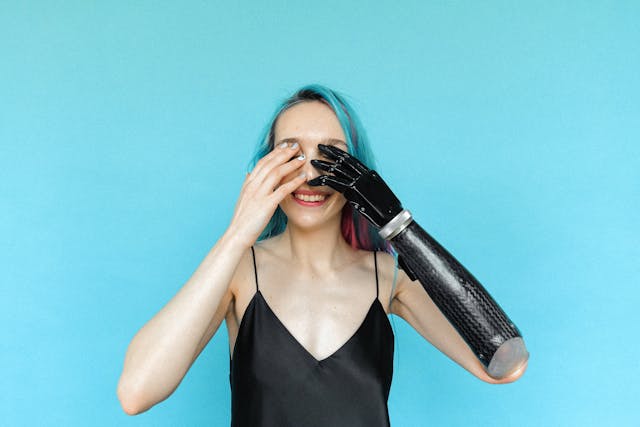
Superhero media has also helped remove the stigma around prosthetics, making them cool, fashionable, and aspirational. Instead of hiding their prosthetic limbs, many people proudly customize them with designs, colors, and features inspired by their favorite superheroes.
This cultural shift has led to:
- More companies offering personalized prosthetic designs.
- Increased interest in affordable, 3D-printed prosthetics.
- A change in how society perceives prosthetic users—not as disabled, but as empowered individuals.
Encouraging Kids with Disabilities to Dream Bigger
For children with limb differences, superhero culture provides confidence and motivation. Many prosthetic companies are now creating superhero-themed prosthetics, such as Iron Man or Black Panther-inspired arms, to help kids feel excited about their prosthetics rather than self-conscious.
By turning prosthetic limbs into symbols of strength rather than reminders of loss, superhero culture is helping children embrace their uniqueness and aim for extraordinary futures.
The Future of Disabled Superheroes in Pop Culture
The rise of disabled superheroes has already made a significant impact, but the future holds even greater potential for authentic, inclusive, and empowering representation. As more filmmakers, comic book creators, and TV producers recognize the importance of diverse storytelling, we can expect to see even more superheroes with prosthetics and disabilities take center stage.
Expanding Disability Representation in Superhero Media
While the number of disabled superheroes has increased, many still remain side characters rather than leading heroes. In most major franchises, superheroes with prosthetics or disabilities are supporting figures, often used to help develop the main (typically able-bodied) hero’s journey.
The next step in disability representation is to push for more disabled characters in leading roles. This means:
- Creating more original superheroes whose disabilities are not the only defining aspect of their character.
- Giving more screen time and depth to existing disabled heroes in major franchises.
- Allowing real prosthetic users and disabled actors to portray these roles instead of casting able-bodied actors.
The demand for authentic representation is growing, and as more audiences embrace diverse storytelling, studios will have no choice but to listen and evolve.
The Role of Technology in Making Superhero Prosthetics a Reality
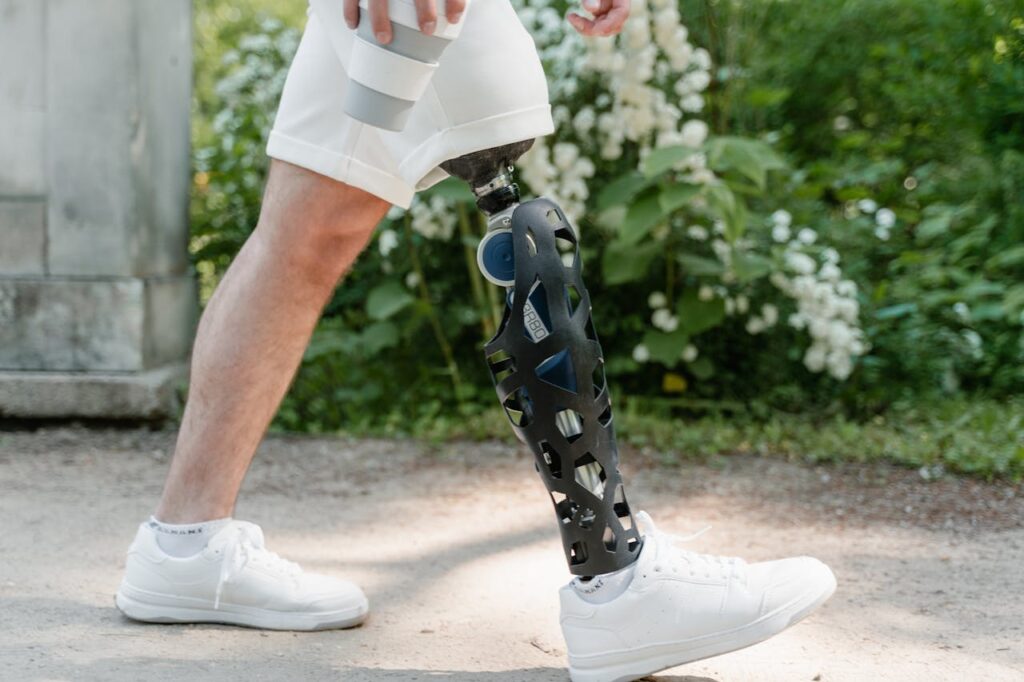
One of the most exciting things about disabled superheroes in pop culture is that they inspire real technological advancements. Engineers, researchers, and prosthetic designers are constantly working to create more advanced, functional, and intuitive prosthetic limbs, drawing inspiration from sci-fi, comic books, and superhero films.
Some exciting developments include:
- Mind-controlled prosthetics that allow users to move artificial limbs just by thinking.
- Haptic feedback technology, enabling users to “feel” sensations through their prosthetic limbs.
- Lightweight and customizable designs, making prosthetics more comfortable, stylish, and accessible.
As technology progresses, the line between fiction and reality continues to blur, bringing us closer to a world where real-life prosthetic users can experience superhero-like abilities.
The Impact of Superhero Culture on Disability Awareness
Superhero media does more than entertain—it educates. The more disabled superheroes appear in pop culture, the more awareness, understanding, and acceptance grows in society.
By seeing strong, independent, and fully capable heroes with disabilities, people begin to:
- Change how they interact with real prosthetic users, treating them as equals rather than as people who need sympathy.
- Advocate for better accessibility in public spaces, workplaces, and schools.
- Support policies that promote disability rights, inclusivity, and prosthetic advancements.
Pop culture has the power to reshape societal attitudes, and disabled superheroes play a crucial role in this movement.
Final Thoughts: Why Representation Matters More Than Ever
The rise of disabled superheroes in pop culture is not just a passing trend—it’s a movement toward greater inclusion and understanding. These characters are proving that disability is not a weakness but a different form of strength, inspiring both prosthetic users and able-bodied individuals alike.
At Robobionics, we believe that representation has the power to change lives. Whether through advanced prosthetic technology or positive portrayals in media, every step toward inclusivity brings us closer to a world where disability is fully accepted, understood, and celebrated.
As pop culture continues to redefine prosthetics and disability, we look forward to a future where all individuals—regardless of physical ability—can see themselves as heroes. Because in reality, strength is not about having two hands or two legs—it’s about resilience, adaptability, and the courage to keep moving forward.
The world is ready for more disabled superheroes. The question is: Is Hollywood ready to give them the spotlight they deserve.



